FRIDAY'S SCRIPT TIP: VISUAL
METAPHORS
The hallmark of a great scene is that is does several things at once in an effortless manner that appears to be unplanned... what the character would naturally do. This requires skill and planning on the part of the writer. Not all great scenes require dialogue - sometimes actions speak louder than words. In the Visual Storytelling Blue Book I look at a bunch of techniques for *showing* feelings and emotions instead of having characters discuss them - which is often unrealistic. As director Frank Capra noted before any of us were born, the goal in a screenplay isn’t to show the character feel the emotions... but to have the audience feel the emotions. Often if a character cries, the audience feels that they don’t need to cry... but igf a character must repress their emotions in a scene, the audience has to do the crying for them. So our goal is to make the *audience* feel something, and that is done through demonstration rather than description. A great tool for that is using a metaphor - a visual representation of the feelings inside the character so that the audience can react on their own...

In Alexander Payne & Jim Taylor's ABOUT SCHMIDT(2002), Jack Nicholson plays the title role - an expert in insurance actuarial tables for Woodmen Insurance who is retiring after dedicating most of his life to charting the exact moment when a man will die given various pieces of personal information for his job. He has compiled his life's work in a series of files and has lovingly placed them in several clearly labeled boxes so that the fellow who replaces him can use them. At exactly 5 pm on his last day he grabs his coat and leaves the office - the boxes containing his files neatly stacked against the wall. His life’s work available for the next person who has his job to learn from.
This story is *about* retirement. That moment in a person’s life when they have worked for 25-40 years at a company and now get the rewards of all of that work - they get to live out the rest of their days on a pension, doing all of those things that they wanted to do over those 25 years of work but just didn’t have the time. They can buy an RV and drive across country seeing all of the sights! They can spend more time with their spouse! They can do everything they have always dreamed of doing!
But we know that dreams don’t always work out. The fantasy of retirement that they have spent those 25-40 years working towards... is often a rather boring reality.
Retirement doesn't suit Schmidt - he gets tired of sitting around the house listening to his wife vacuum. So at 9am he heads down to the Woodmen Building, says "Good morning" to his co-workers as he passes them in the hallway, and enters his office...
Except it isn't his office anymore. The young whipper-snapper hired to replace him is sitting behind the desk. And the desk is in an entirely different spot. And there's no sign of his files (his life's work). He asks the young whipper-snapper if he needs any help with anything. Any questions about how to do the job? Any questions about anything in the files? We understand - through demonstration - that Schmidt is bored with retirement and feels as if he has no purpose in life anymore. When he worked for the insurance company and compiled those detailed files on when and how and why people die, he had a purpose - a reason to exist. People identify themselves with their jobs - whether they admit it or not - and see what they do for 8 hours a day, 40 hours a week, as their contribution to society. They serve an important purpose! Their life has value! And when they retire, that purpose and that value seem to be over... So we understand what this scene is *really* about, and the more Schmidt asks if the new guy needs any help, the more we understand how much Schmidt feels that his life is now without purpose. He isn’t doing anything. He’s just sitting around the house watching his wife vacuum.
Schmidt didn’t have to *tell us* any of this through dialogue, the juxtaposition of the scene where he is bored at home watching his wife vacuum and this scene where he goes back to the office and asks if the whipper-snapper needs any help *demonstrates* that. The audience *feels* it. We feel what Schmidt is feeling.
After Schmidt has asked about every possible thing his replacement might need help with, the young whipper-snapper answers, "No". Then the phone rings and the whipper-snapper answers and has a conversation - completely ignoring Schmidt. As if the old man doesn’t exist. Schmidt looks around the office for his files - his 25 years of work... and they are no longer there. The cabinets have been moved somewhere - maybe to another room so that all of the employees can share in Schmidt’s 25 years of work? That would be a great thing - to have his 25 years of work shared by everyone in the company! The whipper-snapper’s phone call continues, and after a while, Schmidt realizes he's just in the way, grabs his coat and leaves... looking around for his files on his way out. Not visible anywhere.
On the street, he passes the building’s dumpsters... where the boxes containing his files are neatly stacked waiting for the garbage men to take them away. His files are unwanted, he is unwanted. After 25 years, they have thrown Schmidt away. The files are his life's work... and symbolize his life. Not a word of dialogue when Schmidt sees 25 years of his life in the dumpster - the pictures tell the story. The audience *feels* Schmidt’s pain and loss.
That is how a metaphor works. An object is made symbolic of someone or something, so what happens to that object demonstrates what is happening emotionally to the person. It takes thoughts and emotions and feelings that are inside a character and finds a way to externalize them so that the audience can respond using their own emotions. We can feel the character’s pain or joy or love or loss or fear or whatever. How about another example?
SHOW ME LOVE!

In LORD OF THE RINGS: THE FELLOWSHIP OF THE RING (2001) future king Aragorn, Lord Of Dunedain, (Viggo Mortensen) has sworn his heart to elf princess Arwen (Liv Tyler) - even though human/elf love may be illegal in some states. Before he rides off to do battle with Dark Lord Sauron's evil orks, she gives him her medallion to wear close to his heart. That medallion is a symbol of Arwen - what I call a “twitch” or “touchstone” in the Visual Storytelling Blue Book. In this case, a touchstone - a positive token. Even though Aragorn is riding off to battle, that medallion is a reminder of the elf-woman that he loves. She is with him even when she is not there. The audience understands, every time that they see that medallion, that somewhere Arwen is thinking of Aragorn, and Aragorn is thinking of Arwen. We don’t need for him to ever say it.
A year later in THE TWO TOWERS (2002), the medallion is still his most cherished possession. A symbol of his love for Arwen. He has been through battles, he has been on a long arduous journey, and he still wears the symbol of his ardor for Arwen. When he sleeps, he holds the medallion in his hand and dreams of her... and we understand that this medallion is not just metal, but a symbol of his emotions and her emotions. Of their romantic bond.
But the battle rages on, the fellowship has broken, and Aragorn, plus too-short-to see-over-the-wall dwarf Gimli (John Rhys-Davis) and elf warrior Legolas (Orlando Bloom) find themselves in the kingdom of Rohan looking for help. Though the King is intent on remaining neutral, his beautiful sword-wielding daughter, Lady Eowyn (Miranda Otto) sides with Aragorn.... and she falls for him. The two are evenly matched with swords and with wit. Lady Eowyn has finally found a man who is her equal, and romance blossoms. In a battle scene, Aragorn loses his medallion...
What does the audience think when he loses the medallion?
How does the audience feel when he loses the medallion?
What do you think is the audience’s *reaction* to losing the medallion?
When Aragorn returns from the fierce battle, Lady Eowyn decides to profess her love for him... but stops when she sees Legolas handing Aragorn the medallion he had lost. Stops when she sees the way Aragorn holds the medallion, caressing it... as if it were princess Arwen herself. Even though millions of miles may separate the two, the medallion acts as a SYMBOL of their love. It's obvious by the way he holds the medallion, that he is still very much in love with Arwen. So Lady Eowyn turns and walks away - broken hearted. Not a word is spoken in this scene - that symbolic medallion says it all. The audience KNOWS how Aragorn feels and KNOWS how Lady Eowyn feels. We have been taken *inside* the story and allowed to share the feelings of the characters rather than being an outsider who is being told about those feelings through dialogue. We get the feelings first hand, rather than second hand by a character saying how they feel. That is the power of using metaphors.
HOW DO YOU DO THAT?

Using metaphors requires a good imagination on your part and the ability to figure out the core reasons and motivations of your characters. The first thing you need to do is figure out what it is about your character that you want the audience to *feel*. Do you want them to feel cast aside by the world? Do you want them to feel loss? Do you want them to feel love? Do you want them to feel confidence? What is the specific feeling that you want the readers or viewers to feel, that your character is feeling, in this scene? The more specific you can be the better - and that means that you need to understand your characters in order to make the audience understand your characters.
What can be the physical symbol of that emotion? Schmidt feels that he is without purpose or value after he has retired - so what is symbolic of his purpose and worth? Aragorn feels a deep love for Arwen - so what can be symbolic of that love? Often this is the difficult part, because you need to find a physical object that the audience easily sees as symbolic of those emotions or thoughts. In ABOUT SCHMIDT the actuary files are the perfect symbol of his value - 25 years of hard work has created them. Those are *character specific* - if he had been in a different line of work, you would need a different symbol. So knowing your character is required! Using your imagination to come up with that symbol is required! As writers, those actuary files don’t exist until we create them. So we need to know that we are going to use that symbol later so that we can invent it now.
I am all about making the best choice, which means that you need a choice... so whatever you want to show about your character - make a list of possible things that can symbolize that. Give yourself several good choices so that you can select the best. The physical object that the audience will instantly understand is symbolic of that feeling. Sometimes it’s a physical scar on a character that symbolizes an emotional scar. Sometimes it’s an object. In BASIC INSTINCT Michael Douglas’ cop has been dating police psychologist Jeanne Triplehorn for a while and have exchanged apartment keys - she has a keyfob of Homer Simpson. The *apartment keys* symbolize their relationship - and when he asks for his key back, that scene where the key is removed is an *emotional* scene... and later in the film, when she touches that keyfob in her pocket, we know that she is thinking about their relationship. So you will need to select the physical object that best represents the thought or feeling or emotion. We understand what the key really means.
Once we have that symbolic physical item, we have to show the audience what it means. The scene in SCHMIDT where he carefully makes sure that his replacement knows about his files, the scene in RINGS where Arwen gives him the medallion. Sometimes the audience can understand the symbol without a scene that sets it up, like the apartment keys in INSTINCT, or this great film...

THE BEST YEARS OF OUR LIVES (1946) is a gritty, realistic story of soldiers returning after World War 2 that won Best Picture Oscar and six others, and shows the intertwining stories of three different soldiers from the same small town returning home and attempting to readjust to society. It is an amazing example of visual storytelling because the soldier’s thoughts and feelings are never discussed - that is too painful, too private... these are war heroes! So the story demonstrates the problems they are struggling with - alcoholism, losing your limbs, and going from War Hero to unskilled civilian entering the work force. If you haven’t seen this film, check it out. I think Harold Russell is the only actor to win 2 Oscars for the same role - he was an actual soldier who lost both of his arms giving an amazing performance that probably hit way too close to home. He continued as an actor, doing great work, and the first time I saw him was in INSIDE MOVES (1980) as a smart alec supporting character.
One of the three stories stars Dana Andrews as an Air Force Hero who comes home from the war and can't seem to find a job anywhere. He was a Captain in the Air Force - who commanded men... but before he enlisted he worked behind the counter at a soda fountain - the equivalent of a fast food job today. While he was gone, his wife was busy screwing other guys (implied - this is a 40's film - but she worked in a sleazy night club as a waitress). He ends up working at a drugstore for minimum wage - kind of the same type of job he had before the war. His wages are so low, that his wife leaves him, and now he has nothing. We see him working the terrible job, with pushy a-hole customers, and how do we think he feels? Now, these scenes could have had wonderful customers... but that wouldn’t make the audience feel his pain, would it? He eventually loses his temper with a verbally abusive customer and is fired. The worst job there is - and he’s fired from it.
Everybody in town knows him... he was a war hero, but now he's a bum.
He packs his bags, puts on his Airforce uniform (how do you think that makes him feel?), and takes the bus to the nearest Airforce base. He asks the dispatcher if he'd do a favor for an ex-Airforce nose gunner. "What kind of favor?" "Can I hitch a ride on the next plane for the coast?" "Which coast?" "I really don't care." The dispatcher tells him there's a plane leaving at 8 pm, if he can wait. He has nothing else to do, no place else to go.
Andrew kills time by wandering through the airplane graveyard. Hundreds and hundreds of planes, as far as the eye can see, no longer needed after the war. Rusty,
dusty. A crew is dismantling them for the parts. For the scrap metal. They are junk. He is surrounded by Air Force planes which are no longer useful... just as he's no longer useful.
The writers found a metaphor for Andrew' character. The planes ARE Andrews.
We know exactly how useless Andrews is feeling. This is a big emotional moment in
the film, without a word of dialogue. When he finally climbs inside one of the planes,
brushing away the dust, and sits in the nose gunner's seat, you know that he's trying
to recapture those times when he was a hero... someone with a purpose... someone
who was appreciated by those around him. And this is a strong moment in the story. It doesn’t tell the audience how to feel, it doesn’t tell the audience how Andrews feels... it creates a situation using a metaphor that makes the audience feel what Andrews feels. Allows them inside of the story so that they can feel the emotions themselves, instead of watching the story from outside the frame.
Whether your story is about the battle for identity and dignity after retirement or the battle for Middle Earth, to rejoin society after returning from battle, using metaphors is a great way to SHOW how characters feel by using symbols.
COMING SOON!
How Do I do That?
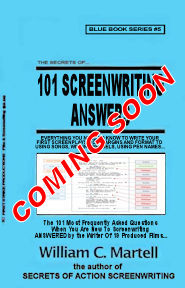
101 SCREENWRITING ANSWERS Blue Book!
New to screenwriting? You probably have questions! How do I get an Agent? How do I write a phone conversation? Do I need a Mentor? What’s does VO and OC and OS mean? What is proper screenplay format? Should I use a pen name? Do I need to movie to Hollywood? What’s the difference between a Producer and a Production Manager, and which should I sell my script to? How do I write a Text Message? Should I Copyright or WGA register my script? Can I Direct or Star? How do I write an Improvised scene? Overcoming Writer’s Block? How do I write a Sex Scene? And many many more! This book has the answers to the 101 Most Asked Questions from new screenwriters! Plus a Glossary of terms so that you can sound like a pro! Everything you need to know to begin writing your screenplay!
All of the answers you need to know, from a working professional screenwriter with 20 produced films and a new movie made for a major streaming service in 2023!
Only $4.99
NEW!!!
Can You Make It bigger?

BLOCKBUSTERS (and BEACH READS) Blue Book!
Writing something EPIC?
Over 500 Pages, ONLY : $4.99!
Thinking about writing a big Disaster Movie? An Historical Epic? An Epic Adventure Film? Or maybe you like Gladiator Movies? This book looks at writing Blockbusters and those Big Fat Beach Read novels - anything epic! Usng movies like JAWS, POSEIDON ADVENTURE, LAWRENCE OF ARABIA, THE GUNS OF NAVARONE, and those MARVEL and FAST & FURIOUS flicks as examples. What *is* a Blockbuster? 107 years of Blockbuster history! Blockbuster Characters. Blockbuster Story Types! Why modern Blockbusters are soap operas! Social Issues in Blcokbusters? Big Emotions! Keeping All Of Those Characters Distinctive! How to avoid the Big problems found in Big Movies and books! More! If you are writing a Big Event Movie or a Big Fat Novel, there are tips and techniques to help you!
Only $4.99
NEW!!
All About Endings!
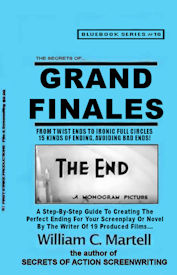
GRAND FINALES Blue Book!
The Perfect Ending For Your Story!
The First Ten Pages Of Your Screenplay Are Critical,
But What About The Last 10 Pages?
Creating the perfect ending to your story! This 100,000 word book shows you how to end your story with a bang, rather than a whimper. Everything from Resolution Order to Act Three Tools to Happy or Sad Endings? to How The Beginning Of Your Story Has Clues To The Ending (in case you were having trouble figuring out how the story should end) to Falling Action to How To Avoid Bad Endings to Writing The Perfect Twist Ending to Setting Up Sequels & Series to Emotional Resolutions to How To Write Post Credit Sequences to Avoiding Deus Ex Machinas, to 20 Different Types Of Ends (and how to write them) and much more! Everything about endings for your screenplay or novel!
Only$4.99
BRAND NEW
All About LOGLINES, TREATMENTS, and PITCHING!

LOGLINES, TREATMENTS, and PITCHING! Blue Book!
Distilling Your Screenplay!
Loglines, Treatments, Pitching, Look Books, Pitch Decks, One Pagers, Rip-O-Matics?
You have written a brilliant 110 page screenplay, but how do you get anyone to read it? You need to distill it down into some form of verbal moonshine or story rocket fuel that will ignite that bored development executive or manager or agent and get them to request your screenplay. But how do you shrink those 110 pages into a 25 word logline or a 2 minute elevator pitch or a one page synopsis or a short paragraph? This 100,000 word book shows you how! Everything you need to know! From common logline mistakes (and how to solve them) to how your pitch can reveal story problems to the 4 types of pitches!
272 pages - ONLY $4.99!
NEW: WRITE IT: FILM IT!

Making Your Own Movie?
Writing An Indie Film?
Writing A Low Budget Genre Script To Sell?
Writing A Made For TV Holiday Movie?
You will be writing for BUDGET. On a standard spec screenplay, you don’t have to think about budget, but these types of screenplays writing with budget in mind is critical!
If you are making your own movie, budget, is even more important - and you need to think about budget *before* you write your screenplay... or you will end up with a script that you can’t afford to make (or is a struggle to make). Everyone is making their own films these days, and even if you have done it before there are lots of great techniques in this book to get more money on screen - for less money! You can make a film that looks like it cost millions for pocket change.
344 pages - SALE:: $7.99!
NEW!

THE MISSION IMPOSSIBLE MOVIES
NEW: Updates On Films 7 & 8 Casting!
All Six Movies analyzed! All of the mission tapes, all of the “that’s impossible!” set pieces and stunts, the cons and capers - and how these scenes work, the twists and double crosses, the tension and suspense (and how to generate it), the concept of each film as a stand alone with a different director calling the shots (broken in the sixth film), the gadgets, the masks, the stories, the co-stars and team members (one team member has been in every film), the stunts Tom Cruise actually did (and the ones he didn’t), and so much more! Over 120,000 words of fun info!
THE MISSION IMPOSSIBLE MOVIES - 347 pages - Only $3.99 !
NO KINDLE REQUIRED! Get the *free* app (any device, except your Mr. Coffee) on the order page on Amazon!

BRAND NEW!
*** THE BOURNE MOVIES
All five "Bourne" movies (including "Legacy" and it's potential sequels) - what are the techniques used to keep the characters and scenes exciting and involving? Reinventing the thriller genre...
or following the "formula"? Five films - each with an interesting experiment! A detailed analysis of each
of the films, the way these thrillers work... as well as a complete list of box office and critical
statistics for each film. This book is great for writers, directors, and just fans of the series.
268 pages - Only $3.99
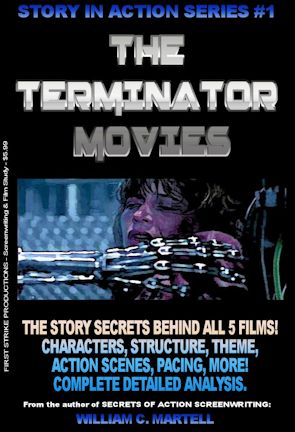
Over 240 pages!
*** THE TERMINATOR MOVIES *** - For Kindle!
He's back! The release of "Terminator: Dark Fate" is set to begin a new trilogy in
the Terminator story... 35 years after the first film was released. What draws us to these films about
a cybernetic organism from the future sent back in time? Why is there a new proposed trilogy every few
years? This book looks at all five Terminator movies from a story standpoint - what makes them work
(or not)? What are the techniques used to keep the characters and scenes exciting and involving? How
about those secret story details you may not have noticed? Containing a detailed analysis of each of
the five films so far, this book delves into the way these stories work... as well as a complete list of
box office and critical statistics for each film. This book is great for writers, directors, and just
fans of the series.
ONLY $3.99 - and no postage!
Tips FAQ

My New Script Secrets Newsletter!

NEW BOOKS!
BRAND NEW
OUTLINES & THE THEMATIC!
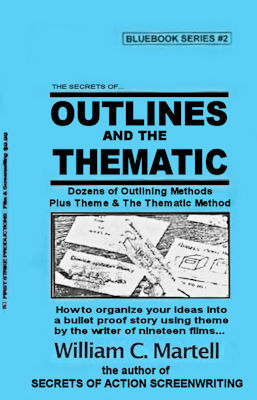
OUTLINES & THE THEMATIC Blue Book.
ARE YOUR SCENES IN THE RIGHT ORDER?
AND ARE THEY THE RIGHT SCENES?
Your story is like a road trip... but where are you going? What's the best route to get there? What are the best sights to see along the way? Just as you plan a vacation instead of just jump in the car and start driving, it's a good idea to plan your story. An artist does sketches before breaking out the oils, so why shouldn't a writer do the same? This Blue Book looks at various outlining methods used by professional screenwriters like Wesley Strick, Paul Schrader, John August, and others... as well as a guest chapter on novel outlines. Plus a whole section on the Thematic Method of generating scenes and characters and other elements that will be part of your outline. The three stages of writing are: Pre-writing, Writing, and Rewriting... this book looks at that first stage and how to use it to improve your screenplays and novels.
Only $4.99!
ALSO NEW!
DESCRIPTION & VOICE Blue Book!
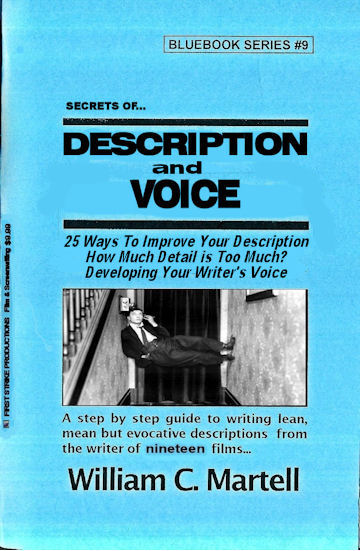
DESCRIPTION & VOICE Blue Book.
IS HALF OF YOUR STORY IN TROUBLE?
Most screenplays are about a 50/50 split between dialogue and description - which means your description is just as important as your dialogue. It just gets less press because the audience never sees it, the same reason why screenwriters get less press than movie stars. But your story will never get to the audience until readers and development executives read your script... so it is a very important factor. Until the movie is made the screenplay is the movie and must be just as exciting as the movie. So how do you make your screenplay exciting to read? Description is important in a novel as well, and the “audience” does read it... how do we write riveting description?
Only $4.99!
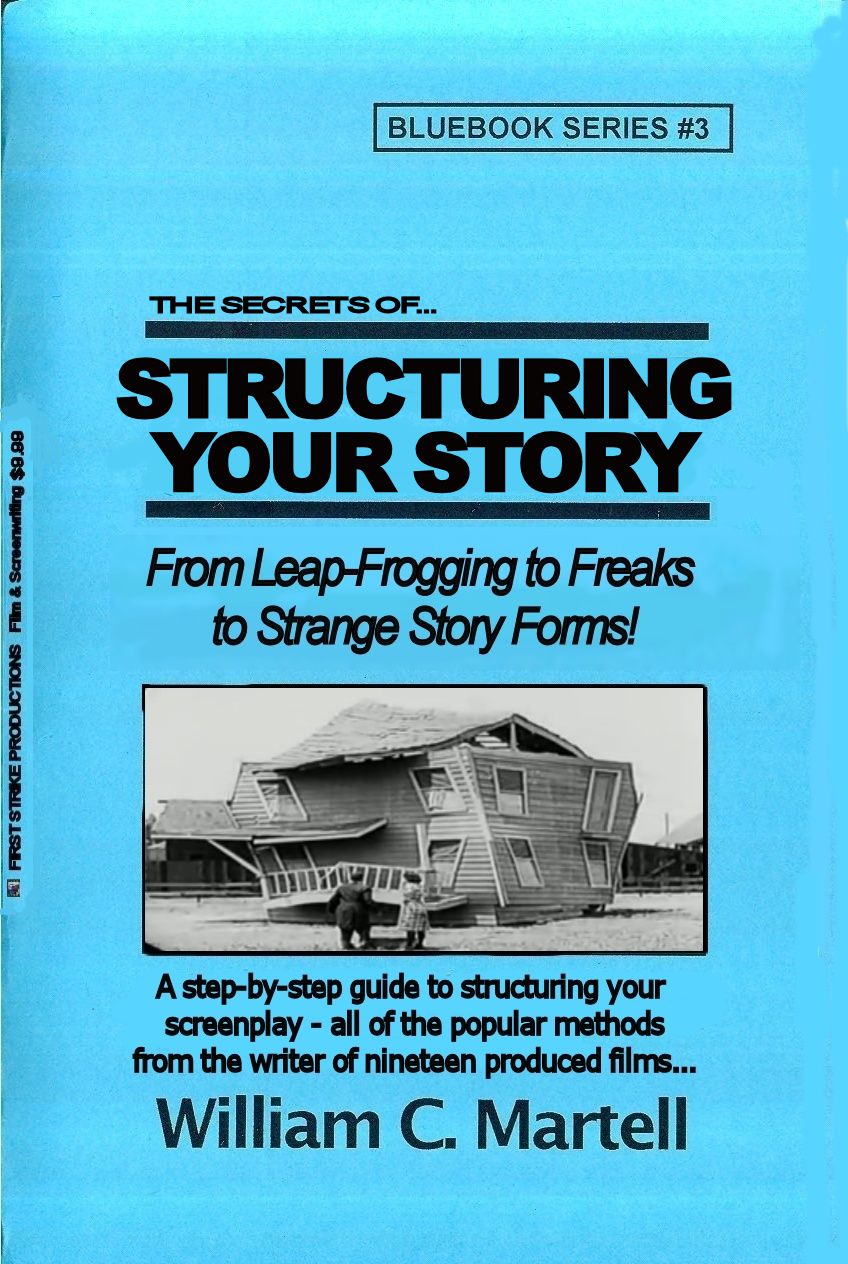
NEW AND HOT!
*** STRUCTURING YOUR STORY *** - For Kindle!
William Goldman says the most important single element of any screenplay is structure. It’s the skeleton under the flesh and blood of your story. Without it, you have a spineless, formless, mess... a slug! How do you make sure your structure is strong enough to support your story? How do you prevent your story from becoming a slug? This Blue Book explores different types of popular structures from the basic three act structure to more obscure methods like leap-frogging. We also look at structure as a verb as well as a noun, and techniques for structuring your story for maximum emotional impact. Most of the other books just look at *structure* and ignore the art of *structuring* your story. Techniques to make your story a page turner... instead of a slug!
Only $4.99 - and no postage!
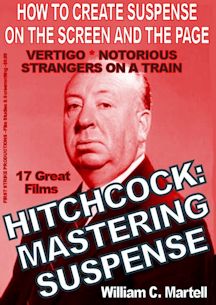
LEARN SUSPENSE FROM THE MASTER!
*** HITCHCOCK: MASTERING SUSPENSE *** - For Kindle!
Alfred Hitchcock, who directed 52 movies, was known as the *Master Of Suspense*; but what exactly is suspense and how can *we* master it? How does suspense work? How can *we* create “Hitchcockian” suspense scenes in our screenplays, novels, stories and films?
This book uses seventeen of Hitchcock’s films to show the difference between suspense and surprise, how to use “focus objects” to create suspense, the 20 iconic suspense scenes and situations, how plot twists work, using secrets for suspense, how to use Dread (the cousin of suspense) in horror stories, and dozens of other amazing storytelling lessons. From classics like “Strangers On A Train” and “The Birds” and “Vertigo” and “To Catch A Thief” to older films from the British period like “The 39 Steps” and “The Man Who Knew Too Much” to his hits from the silent era like “The Lodger” (about Jack The Ripper), we’ll look at all of the techniques to create suspense!
Only $5.99

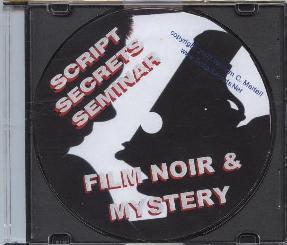
AUDIO CLASS!
NOIR & MYSTERY80 minute MP3 packed with information on writing Film Noir and Mystery scripts. Using examples from CHINATOWN to OUT OF THE PAST to DOUBLE INDEMNITY you'll learn how to create stories in this dark, twisted genre. How to plant clues, red herrings, suspects, victims, spider women, fallen heroes, the funhouse mirror world of noir supporting characters... and the origins of Film Noir in literature Noir dialogue and how noir endings are different than any other genre. All of the critical elements necessary to write in this critically popular genre.
The Noir & Mystery Class is only $15 (plus $5 S&H). First 20 on Limited Black Disk!
RECESSION SALE! $5 OFF!
IDEAS AND CREATIVITY - 80 minute MP3 packed with information. Tools to find ideas that are both personal *and* commercial. Hollywood wants scripts with High Concept stories... but not stupid scripts. Developing *intelligent* high concept ideas. How to turn your personal story into a blockbuster - or find your personal story in a high concept idea. Brainstorming and being creative. Ideas and Creativity is $10.00 (plus $5 S&H)
WRITING INDIES - Writing an Indie film? This class covers everything you need to know - from Central Locations to Confined Cameos. Using examples from SWINGERS, THE COOLER, STATION AGENT and others, this 80 minute MP3 is packed with information. How Indoe films challenge the audience (while mainstream films reassure the audience). Structures, using BOYS DON'T CRY, RUN LOLA RUN, HILARY & JACKIE, and others as example. Writing for a budget, writing for non-actors, getting the most production value out of your budget. Writing Indies is $10.00 (plus $5 S&H)
WRITING HORROR - The essentials of a horror screenplay - what do ROSEMARY'S BABY, NIGHT OF THE LIVING DEAD, THE EXORCIST, BRIDE OF FRANKENSTEIN, THE OTHERS and OPEN WATER have in common? This class will tell you! All of the critical elements necessary to write a script that scares the pants off the audience. Writing Horror is $10.00 (plus $5 S&H).
Click here for more information on CLASS MP3s!
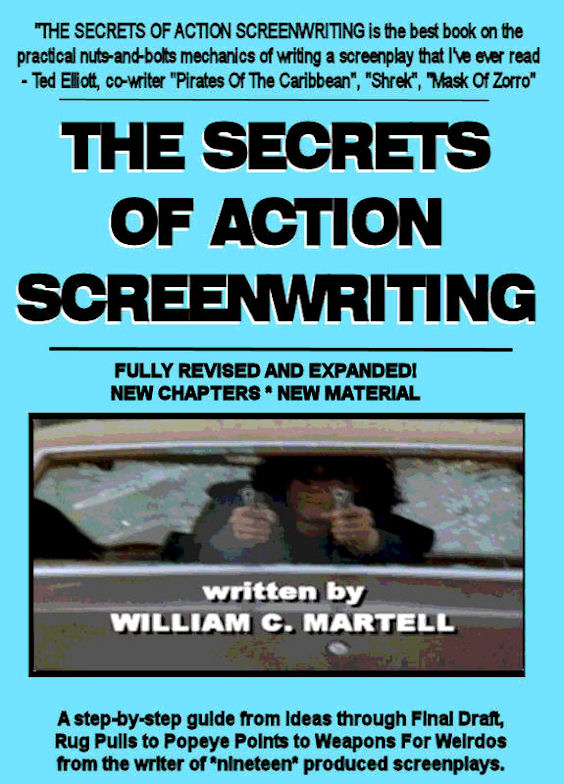
THE BOOK THAT STARTED IT ALL!
*** THE SECRETS OF ACTION SCREENWRITING *** - For Kindle!
*** THE SECRETS OF ACTION SCREENWRITING *** - For Nook!
Why pay $510 for a used version of the 240 page 2000 version that used to retail for $21.95? (check it out!) when
you can get the NEW EXPANDED VERSION - over 500 pages - for just $9.99? New chapters, New examples, New techniques!
"SECRETS OF ACTION SCREENWRITING is the
best book on the practical nuts-and-bolts mechanics of writing a screenplay I've ever read."
- Ted Elliott, co-writer of MASK OF ZORRO, SHREK, PIRATES OF THE CARIBBEAN and the sequels (with Terry Rossio). (ie; 4 of the top 20 Box Office Hits Of ALL TIME.)
Only $9.99 - and no postage!
READY TO BREAK IN?
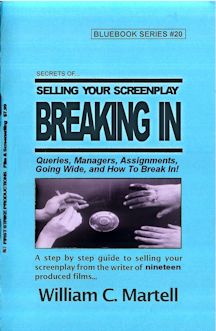
NEW!
*** BREAKING IN BLUE BOOK *** - For Kindle!
Should really be called the BUSINESS BLUE BOOK because it covers almost everything you will need to
know for your screenwriting career: from thinking like a producer and learning to speak their language,
to query letters and finding a manager or agent, to making connections (at home and in Hollywood) and
networking, to the different kinds of meetings you are will have at Studios, to the difference between
a producer and a studio, to landing an assignment at that meeting and what is required of you when you
are working under contract, to contracts and options and lawyers and... when to run from a deal!
Information you can use *now* to move your career forward! It's all here in the Biggest Blue Book yet!
Print version was 48 pages, Kindle version is over 400 pages!
$4.99 - and no postage!
NO KINDLE REQUIRED! Get the *free* app (any device, except your Mr. Coffee) on the order page on Amazon!

STORY: WELL TOLD!
*** STORY: WELL TOLD *** - For Kindle!
This book takes you step-by-step through the construction of a story... and how to tell a story well, why Story always starts with character... but ISN'T character, Breaking Your Story, Irony, Planting Information, Evolving Story, Leaving No Dramatic Stone Unturned, The Three Greek Unities, The Importance Of Stakes, The Thematic Method, and how to create personal stories with blockbuster potential. Ready to tell a story?
Print version was 48 pages, Kindle version is over 85,000 words - 251 pages!
Only $4.99 - and no postage!
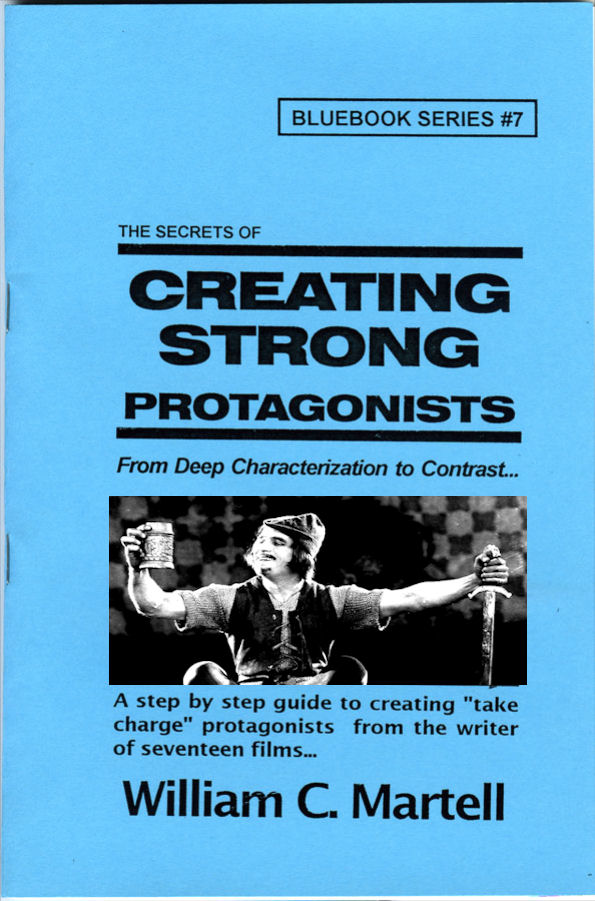
MOVIES ARE CHARACTERS!
*** CREATING STRONG PROTAGONISTS *** - For Kindle!
*** CREATING STRONG PROTAGONISTS *** - For Nook!
Expanded version with more ways to create interesting protagonists! A step-by-step guide to creating "take charge" protagonists. Screenplays are about characters in conflict... characters in emotional turmoil... Strong three dimensional protagonists who can find solutions to their problems in 110 pages. But how do you create characters like this? How do you turn words into flesh and blood? Character issues, Knowing Who Is The Boss, Tapping into YOUR fears, The Naked Character, Pulp Friction, Man With A Plan, Character Arcs, Avoiding Cliche People, Deep Characterization, Problem Protagonists, 12 Ways To Create Likable Protagonists (even if they are criminals), Active vs. Reactive, The Third Dimension In Character, Relationships, Ensemble Scripts, and much, much more. Print version is 48 pages, Kindle version is once again around 205 pages!
ONLY $4.99 - and no postage!
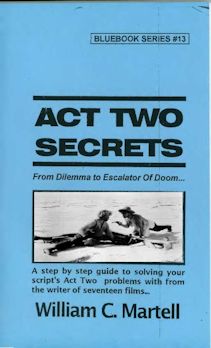
ACT TWO SOLUTIONS!
*** ACT TWO SECRETS *** - For Kindle!
Expanded version with more techniques to help you through the desert of Act Two! Subjects Include: What Is Act Two? Inside Moves, The 2 Ps: Purpose & Pacing, The 4Ds: Dilemma, Denial, Drama and Decision, Momentum, the Two Act Twos, Subplot Prisms, Deadlines, Drive, Levels Of Conflict, Escalation, When Act Two Begins and When Act Two Ends, Scene Order, Bite Sized Pieces, Common Act Two Issues, Plot Devices For Act Two, and dozens of others. Over 67,000 words (that’s well over 200 pages) of tools and techniques to get you through the desert of Act Two alive!
Print version was 48 pages, Kindle version is well over 200 pages!
ONLY $4.99 - and no postage!
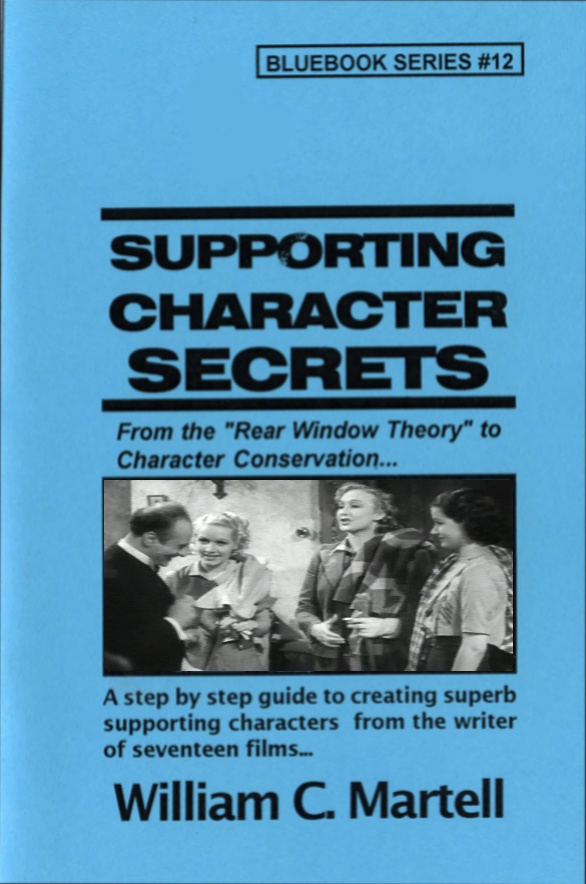
SUBPLOTS?
*** SUPPORTING CHARACTER SECRETS *** - For Kindle! (Exclusive)
Expanded version with more techniques to flesh out your Supporting Characters and make them individuals. Using the hit movie BRIDESMAIDS as well as other comedies like THE HANGOVER and TED and HIGH FIDELITY and
40 YEAR OLD VIRGIN and many other examples we look at ways to make your Supporting Characters come alive on the page.
Print version was 48 pages, Kindle version is around 170 pages!
ONLY $4.99 - and no postage!

ADVICE FROM 1920!
*** VINTAGE #1: HOW TO WRITE PHOTOPLAYS *** - For Kindle!
***
Screenwriting books have been around as long as films have. This series reprints vintage screenwriting books with a new introduction and history, plus new articles which look at how these lessons from almost 100 years ago apply to today’s screenplays. Anita Loos book is filled with information which still applies.
In addition to the full text of the original book, you get the full screenplay to Miss Loos' hit THE LOVE EXPERT, plus several new articles on the time period and women in Hollywood.
ONLY $2.99 - and no postage!
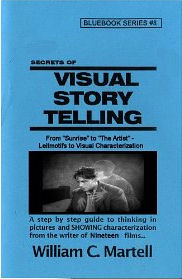
I WRITE PICTURES!
*** VISUAL STORYTELLING *** - For Kindle! (exclusive)
Show Don't Tell - but *how* do you do that? Here are techniques to tell stories visually! Using Oscar Winning Films and Oscar Nominated Films as our primary examples: from the first Best Picture Winner "Sunrise" (1927) to the Oscar Nominated "The Artist" (which takes place in 1927) with stops along the way Pixar's "Up" and Best Original Screenplay Winner "Breaking Away" (a small indie style drama - told visually) as well as "Witness" and other Oscar Winners as examples... plus RISE OF THE PLANET OF THE APES. Print version is 48 pages, Kindle version is over 200 pages!
ONLY $4.99 - and no postage!
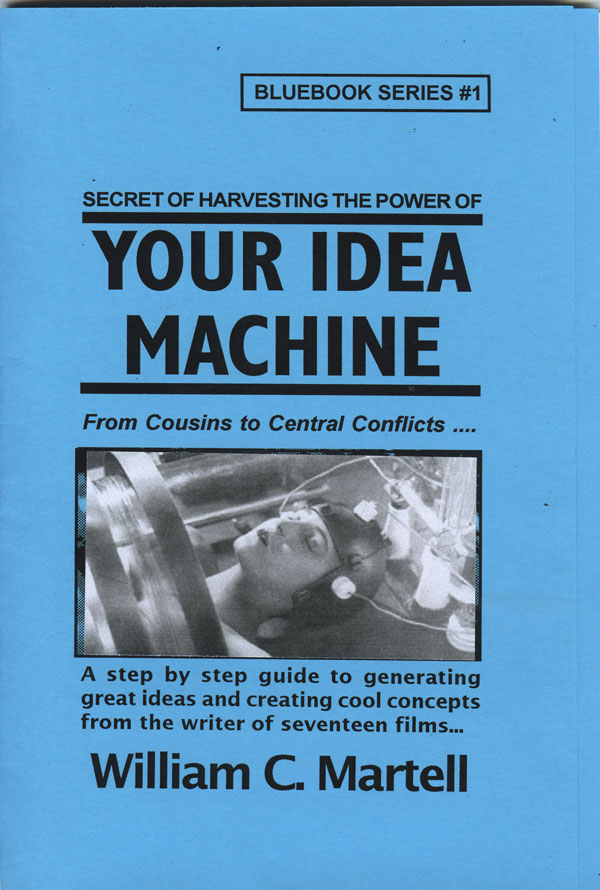
BEST SELLER!
*** YOUR IDEA MACHINE *** - For Kindle!
*** YOUR IDEA MACHINE *** - For Nook!
Expanded version with more ways to find great ideas! Your screenplay is going to begin with an idea. There are good ideas and bad ideas and commercial ideas and personal ideas. But where do you find ideas in the first place? This handbook explores different methods for finding or generating ideas, and combining those ideas into concepts that sell. The Idea Bank, Fifteen Places To Find Ideas, Good Ideas And Bad Ideas, Ideas From Locations And Elements, Keeping Track Of Your Ideas, Idea Theft - What Can You Do? Weird Ways To Connect Ideas, Combing Ideas To Create Concepts, High Concepts - What Are They? Creating The Killer Concept, Substitution - Lion Tamers & Hitmen, Creating Blockbuster Concepts, Magnification And The Matrix, Conflict Within Concept, Concepts With Visual Conflict, Avoiding Episodic Concepts, much more! Print version is 48 pages, Kindle version is over 175 pages!
Only $4.99 - and no postage!

PRO DIALOGUE TECHNIQUES!
*** DIALOGUE SECRETS *** - For Kindle!
*** DIALOGUE SECRETS *** - For Nook!
Expanded version with more ways to create interesting dialogue! How to remove bad dialogue (and what *is* bad dialogue), First Hand Dialogue, Awful Exposition, Realism, 50 Professional Dialogue Techniques you can use *today*, Subtext, Subtitles, Humor, Sizzling Banter, *Anti-Dialogue*, Speeches, and more. Tools you can use to make your dialogue sizzle! Special sections that use dialogue examples from movies as diverse as "Bringing Up Baby", "Psycho", "Double Indemnity", "Notorious", the Oscar nominated "You Can Count On Me", "His Girl Friday", and many more! Print version is 48 pages, Kindle version is over 175 pages!
Only $4.99 - and no postage!

Use your creative energy to focus on the content; let Final Draft take care of the style. Final Draft is the number-one selling application specifically designed for writing movie scripts, television episodics and stage plays. Its ease-of-use and time-saving features have attracted writers for almost two decades positioning Final Draft as the Professional Screenwriters Choice. Final Draft power users include Academy, Emmy and BAFTA award winning writers like Oliver Stone, Tom Hanks, Alan Ball, J.J. Abrams, James Cameron and more.
* * * Buy It!
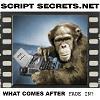
|
|
|
|
|
E BOOKS PAGE
|
|
 E BOOKS: New Blue Books and Novelettes!
E BOOKS: New Blue Books and Novelettes!
I am expanding all of the Blue Books from around 44 pages of
text to around 200 pages! Some are over 250 pages! See what is availabale and what is coming soon!Also, I've been writing Novelletes and there
will soon be novels.
E BOOKS: BLUE BOOKS & NOVELLETES
|
|
ONLINE CLASSES
|
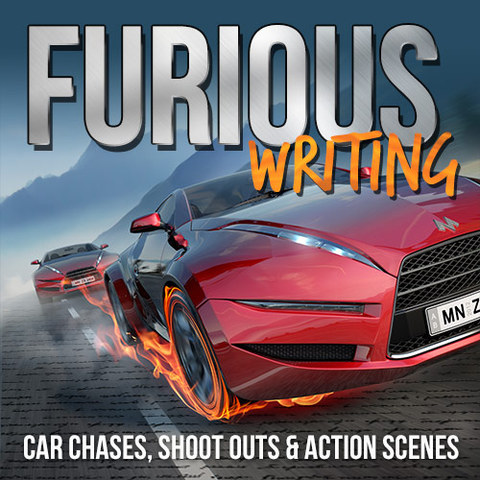
|
|
MY OTHER SITES
|
|
B MOVIE WORLD
Cult Films, Exploitation, Bikers & Women In Prison, Monster Movies.
FIRST STRIKE PRODUCTIONS
Producing my own scripts, investment possibilities, pipe dreams.
|
|
NAKED SCREENWRITING MP3s
|
|
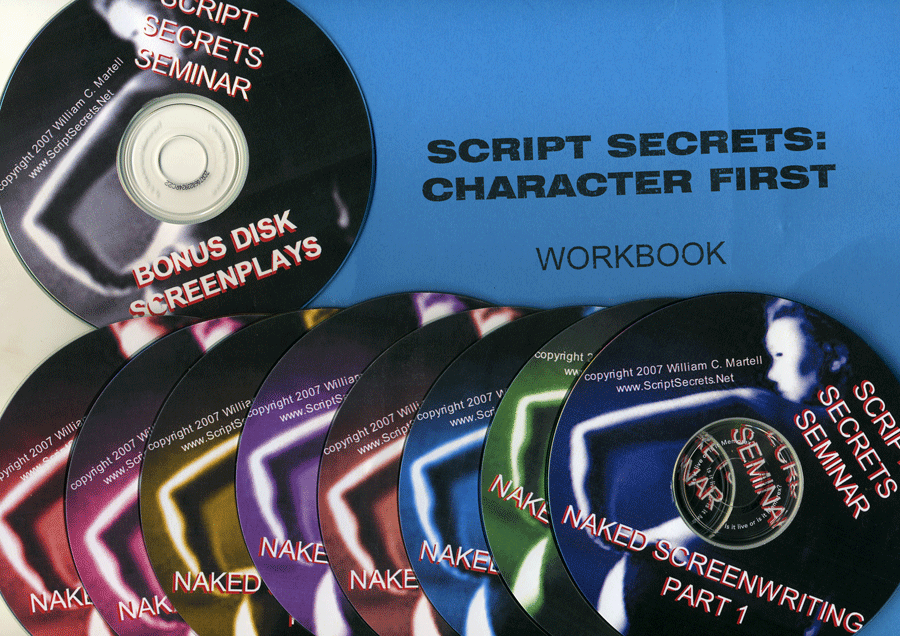 The NAKED SCREENWRITING CLASS ON MP3!
The 2001 London Class on 8 MP3s! Recorded *live* the morning after the Raindance Film Festival
wrapped. The two day class on 8MP3s, plus a workbook, plus a bonus MP3 with PDFs.
The NAKED SCREENWRITING CLASS ON MP3!
The 2001 London Class on 8 MP3s! Recorded *live* the morning after the Raindance Film Festival
wrapped. The two day class on 8MP3s, plus a workbook, plus a bonus MP3 with PDFs.
The 2 Day Class on MP3!
|
|
BOOKSTORE
|
|
Every screenwriting book in the world!
SCREENWRITER'S BOOKSTORE
In Association With Amazon.com
From the latest screenwriting book to
guides for finding agents and producers... all with at the
Amazon.com discount!
|
|
BOOKLETS & PRODUCTS
|
|
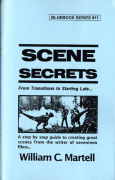 FIRST STRIKE BLUE BOOKS
FIRST STRIKE BLUE BOOKS
Each Blue Book is 48
pages and focuses on a different aspect of screenwriting. Dialogue. Visual Storytelling. Your First Ten Pages. Act 2 Booster. Protagonists. Great Endings.
Seventeen Blue Books now available!
THE SECRETS OF ACTION SCREENWRITING The Best Nuts & Bolts Screenwriting Book On The
Market!
|
|
BILL'S CORNER
|
|
My
nineteen produced films, interviews with me in magazines,
several sample scripts, my available scripts list... And MORE!
...............................BILL'S CORNER
Available Scripts
|
|
CLASSES ON MP3
|
|
 CLASSES ON MP3! Take a class on MP3! GUERRILLA MARKETING - NO AGENT? NO PROBLEM! and WRITING THRILLERS (2 Full length classes on MP3). Now Available: IDEAS & CREATIVITY, WRITING HORROR, WRITING INDIE FILMS, more!
CLASSES ON MP3! Take a class on MP3! GUERRILLA MARKETING - NO AGENT? NO PROBLEM! and WRITING THRILLERS (2 Full length classes on MP3). Now Available: IDEAS & CREATIVITY, WRITING HORROR, WRITING INDIE FILMS, more!
Take classes on MP3!
|
|
|
|
|

